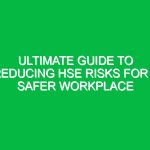Introduction
In the realm of Health, Safety, and Environment (HSE), the term “hazard” is not merely a word; it encapsulates a vital concept that plays a significant role in Workplace Safety and environmental protection. Understanding how to spell hazard correctly is essential for professionals within this field, as it is foundational to effective communication and documentation. This article delves into the intricacies of spelling “hazard,” its relevance in the HSE context, and the broader implications of Hazards in Workplace Safety and environmental health.
Spelling “hazard” may seem straightforward, but its implications extend far beyond mere letters. In HSE, a hazard refers to a potential source of harm or adverse effect on individuals, property, or the environment. The correct spelling is critical, as miscommunication or misunderstanding can lead to severe consequences, including workplace accidents, regulatory violations, and environmental damage. Therefore, mastering the correct spelling and understanding its application is paramount for HSE professionals.
The Importance of Correct Spelling in HSE
Spelling “hazard” accurately is crucial for several reasons:
- Clarity in Communication: Clear communication is vital in any professional environment, especially in HSE, where miscommunication can result in life-threatening situations. Spelling errors can lead to misunderstandings about Safety protocols, risk assessments, and emergency Procedures.
- Documentation Accuracy: HSE professionals often engage in extensive documentation, including reports, training materials, and Safety data sheets. Accurate spelling ensures that documents are professional and credible, thereby enhancing their effectiveness.
- Regulatory Compliance: Various Regulations and Standards governing Workplace Safety require precise language. The correct spelling of terms like hazard is essential for compliance with legal requirements, ensuring organizations avoid penalties.
Understanding Hazards in HSE
To grasp the significance of the term “hazard,” one must explore its various dimensions within the HSE framework. Hazards can be classified into several categories, each with unique characteristics and implications:
1. Physical Hazards
Physical hazards are environmental factors that can cause harm without direct contact. Examples include:
- Noise: Excessive noise in the workplace can lead to hearing loss and decreased productivity.
- Radiation: Exposure to ionizing or non-ionizing radiation can pose significant health risks, necessitating strict Control Measures.
2. Chemical Hazards
Chemical hazards arise from exposure to harmful substances. These can include:
- Toxic Chemicals: Substances like asbestos, lead, and solvents can cause severe health issues.
- Flammable Materials: Chemicals that can ignite pose fire hazards, requiring stringent storage and handling protocols.
3. Biological Hazards
Biological hazards involve exposure to harmful microorganisms. Common examples include:
- Bacteria and Viruses: These can cause infectious diseases, particularly in healthcare and laboratory settings.
- Allergens: Substances that trigger allergic reactions can lead to significant health issues for sensitive individuals.
4. Ergonomic Hazards
Ergonomic hazards relate to workplace design and can lead to musculoskeletal injuries. Examples include:
- Poorly Designed Workstations: Inadequate seating or improper tool usage can cause long-term injuries.
- Repetitive Motion: Tasks requiring repetitive movements can lead to chronic pain and discomfort.
Spelling and Identifying Hazards
Once you understand the types of hazards, the focus shifts to effectively identifying and documenting them. Here’s how to ensure you spell hazard correctly in your reports and communications:
1. Use Standardized Terminology
In HSE, standardized terminology is vital. Always refer to established guidelines and frameworks. For instance, the Occupational Safety and Health Administration (OSHA) and other bodies provide glossaries that include terms related to hazards. Familiarize yourself with these resources to ensure you are using the correct terminology.
2. Double-Check Documentation
Before finalizing any HSE reports or documents, always double-check your spelling. Simple errors can lead to significant misunderstandings. Consider using spell-check tools and grammar checkers, which can catch most mistakes. However, don’t solely rely on technology—your knowledge and awareness are essential.
3. Seek Feedback
Encouraging a culture of feedback within your organization can help catch errors before they become problematic. Peer reviews of safety documents can clarify terminology and improve overall communication.
Real-Life Implications of Miscommunication
To illustrate the importance of spelling “hazard” correctly, consider a hypothetical scenario in a chemical manufacturing plant. An employee submits a report on the presence of a “hazard” in the storage area. However, due to a typographical error, the term is spelled incorrectly, leading to confusion.
As a result, the safety team misinterprets the report, deciding that the area is safe rather than recognizing it as a potential risk. This oversight could lead to unaddressed chemical exposure, resulting in health issues for workers and possible regulatory penalties for the company.
This example highlights the need for precise language in HSE communications. The impact of misspelling critical terms like hazard can extend beyond the workplace, affecting community safety and environmental health.
Regulations and Standards Impacting Hazard Management
Various regulations and standards govern the identification and management of hazards within workplaces. Understanding these can further emphasize the importance of correct spelling and terminology.
1. osha Standards
The Occupational Safety and Health Administration (OSHA) outlines specific regulations regarding workplace hazards. Incorrectly documenting or communicating hazards can lead to non-compliance, resulting in fines or legal actions.
2. ISO Standards
The International Organization for Standardization (ISO) has established standards such as ISO 45001 for Occupational Health and safety management systems. These standards stress the importance of clear, effective communication regarding hazards, reinforcing the need for accurate spelling.
Best Practices for Hazard Communication
To ensure that hazards are effectively communicated within your organization, consider adopting the following Best Practices:
1. Training and Awareness
Provide regular Training sessions on hazard identification and documentation for employees. This training should cover the significance of spelling and terminology.
2. Use Visual Aids
Incorporate visual aids such as charts, infographics, and signage that clearly spell out hazards. Visual representation can enhance understanding and retention among workers.
3. Foster Open Dialogue
Encourage an environment where employees feel comfortable reporting hazards and discussing safety concerns. Open dialogue can facilitate better hazard identification and management.
Conclusion
In conclusion, spelling “hazard” correctly is more than a trivial matter; it is a fundamental aspect of effective communication within the Health, Safety, and Environment domain. From facilitating clear documentation to ensuring regulatory compliance, the implications of this simple term are profound.
By understanding the various types of hazards and the importance of precision in spelling, HSE professionals can significantly enhance Workplace Safety and environmental protection. As you navigate the complexities of hazard management, remember that every detail counts. Accurate spelling can make a difference in fostering a safe and compliant workplace for everyone involved.
In a world where safety matters most, take the time to ensure you know how to spell hazard correctly and communicate its implications effectively. Your commitment to clarity and accuracy can contribute to a safer, healthier environment for all.


